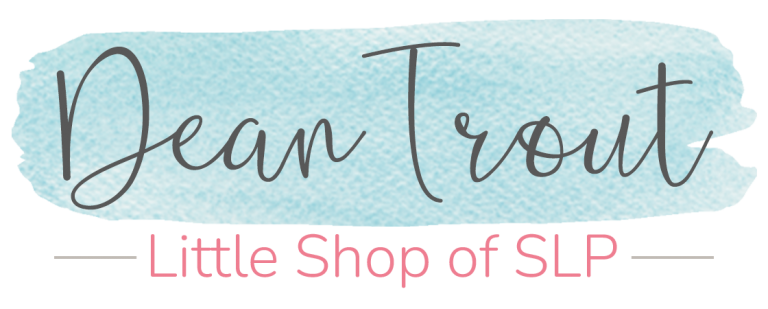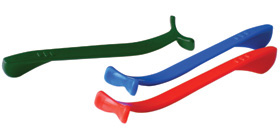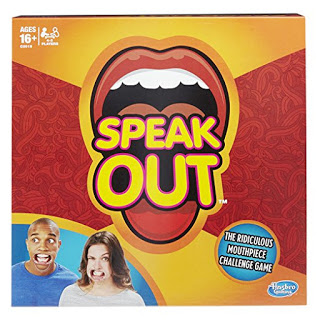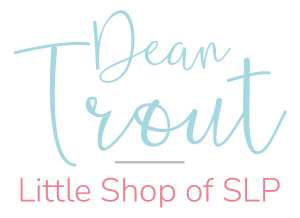When I was blogging as 2 Gals Speech Products a few years back, I wrote of series of posts on how to elicit the most common articulation sounds. I want to revise and update that series because it was so well liked by so many beginning SLPs.
I’m going to launch the series today with my eight best tips for getting that challenging R. Like you I had not always been so successful with R but through many years of trial and error and experience, I have learned a thing or two.
TIP #1 Visual Verbal Label
I’ve heard the R sound labeled as many different and creative things. Here are a few from which you might wish to choose: (1) the Rooster Sound; (2) Growling Dog/Bear Sound “grrrr”; (3) the Seal sound; (4) the Siren Sound; and (5) the Pirate Sound. I think your choice will be guided by the particular R sound you are trying to teach, as well as, with which the child can identify.
TIP #2 Shape from /i/ (long E)
Have the child produce /i/ several times until s/he can grasp the concept that the tongue is wide and touching the sides of the upper teeth midway back in his mouth. Once you are sure they fully understand and have control of their tongue tell them to keep the tongue touching their teeth as they slide the tongue all the way back to their molars. They should shape from /i/ to an /r/.
TIP #3 Shape from /j/ (Y sound)
This utilizes the same basic approach as for /i/. You are going to say /j/ as they move the tongue back until it comes out /r/. The difference is that the /j/ will position the tongue higher in the mouth!
TIP #4 Manually Move the Tongue Back
There is an assortment of things you can use to push the tongue back. One is the ever popular tongue depressor, but I’ve never liked it as I feel like I’m hurting the child. (That’s just my personal opinion.) Instead, I use a dental swab. I push the tongue back with it and have the child bite on the stick portion that is now extending out of their mouth to hold placement and tell them to say /r/ after me (with the dental swap in their mouth). I like this because it keeps the child from relaxing the tongue and sliding it under the swab, due to the sponge on the end. It is just one of those things that work for me.
I read in a blog by Alexandra Streeter (https://community.advanceweb.com/blogs/sp_2/default.aspx) that she likes to use a dental floss holder as a tongue placement tool for R. That is also one of Natalie Snyders favorites.
There is also a product called Tongue LifteR that is readily available in the speech catalogs. I’ve never used it.
TIP #5 Cue with WIDE, UP, and BACK
I verbally cue with those words to remind the child of correct placement. The tongue has to be up high, all the way in the back of the mouth, and it has to be wide-touching the side of gums above the molars! I also use a hand signal as I am saying that. My hand signal is the letter Y from the manual alphabet, which represents wide for my purpose, I move it up high and back beside my face as I give that cue. I fade the verbal cue and use just the hand signal as therapy progresses. When using this technique we need to remember that instead of moving our hand towards the back of our mouths, to move it forward towards the child for further emphasis of the back of their mouths.
Again referencing Alexandra Streeter’s blog, she suggests using peanut butter on the sides of the molars to cue for placement. I would also remind you to check for food allergies before using food products in therapy.*
TIP #6 SMILE
A simple strategy to eliminate the insertion of /w/ is to tell the child to smile. You just can’t say /w/ while you are smiling!
I am hearing from some SLPs that Hasbro’s new game Speak Out that uses dental mouth openers are great for eliminating that /w/ for /r/.
TIP #7 Touch Above Back Teeth
As you have heard me say 1000 times already in previous posts, some kids just don’t “get it” when it comes to what you are wanting them to do and many times all it takes is a simple adjustment in our instructions. One such adjustment is to tell the child to put their tongue ABOVE the back teeth. That will usually get that tongue higher up in the mouth and will make a world of difference in their production.
TIP #8 R Trrrreasure
You know I couldn’t possibly write a blog without mentioning Dr. Caroline Bowen. She has an interesting strategy that involves teaching /r/ from /tr/ I’ll share it via this link
I would like to mention a few programs currently on the market that are popular with many SLPs for working with R. I’m not endorsing any of these I’m just making you aware of them in case you had not heard of them.
I will share that I have a few R specific resources in my TpT store.








8 thoughts on “My 8 Best Tips for Eliciting the R Sound.”
Nice tips! When it comes to the R sound, we can never have enough!
Sometimes you just have to keep on trying different things.
Thank you for these tips! I'm definitely going to try /j/ to see if I can get the placement higher! I've always been an /i/ girl for the bunched /r/.
I am ready to try out some of these tips! Thank you for these great ideas, we need many tricks up our sleeves to conquer that "r".
OH MY GOODNESS!!!! I just used one of your tips on a student who had an "okay but not great /r/" and SHE FINALLY FOUND HER STRONG /R/!!!! The smile on her face was amazing (as was mine), thank you for your tips!!!
Dear Unknown, you just made my day!! I am retired now and love to share those tips and tricks I learned from all those years of working with children. To help you help them is my hearts desire with this blog 🙂 Thank you for taking the time to let me know how it went for you!
Superb i really enjoyed very much with this article here. Really its a amazing article i had ever read. I hope it will help a lot for all. Thank you so much for this amazing posts and please keep update like this excellent article.
Best Laser Clinic In Chennai
Best Implant Clinic In Chennai
nice information . thanks for shaaring.
ดูหนังฝรั่ง